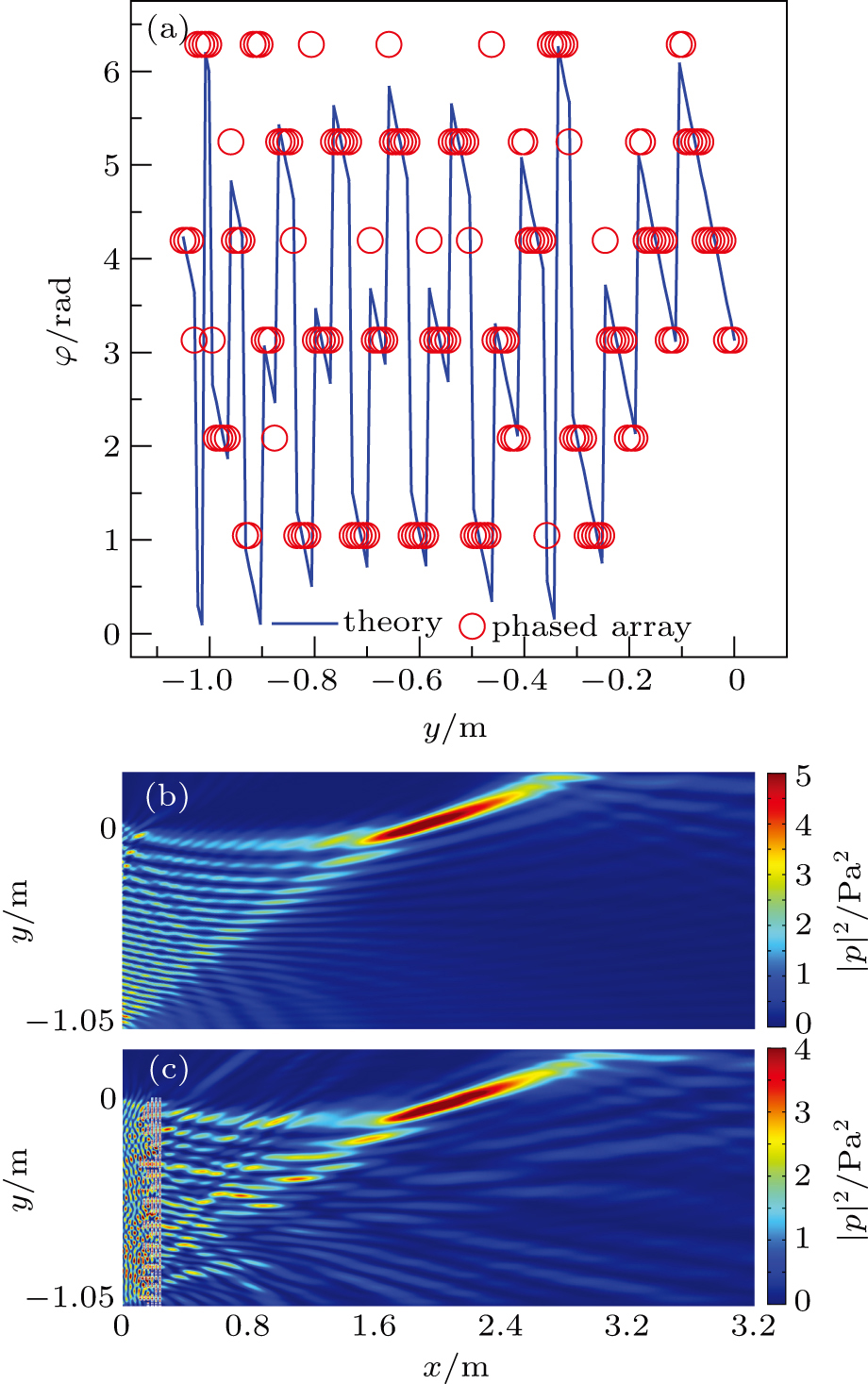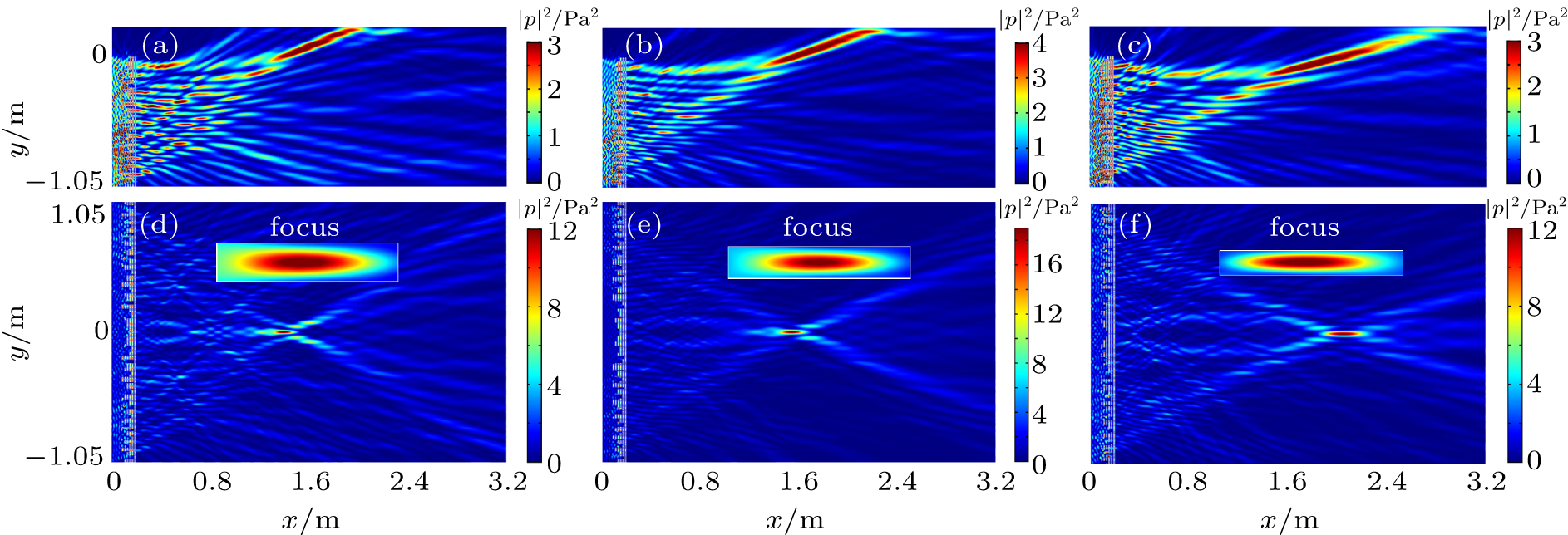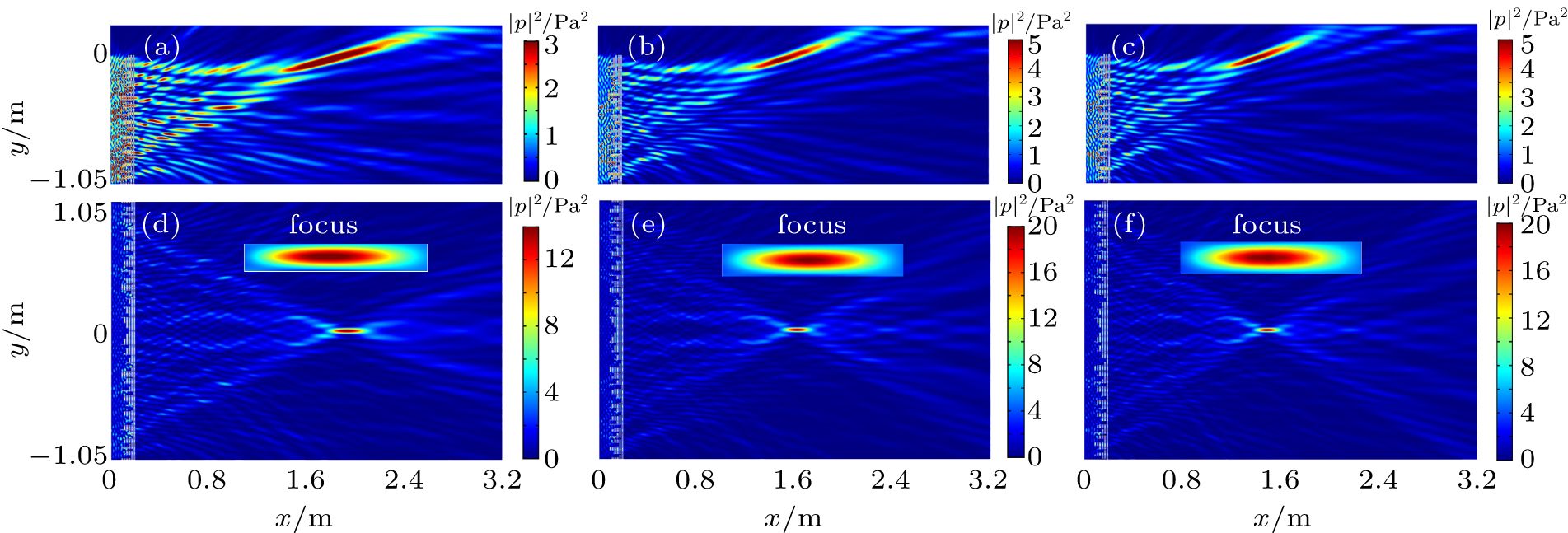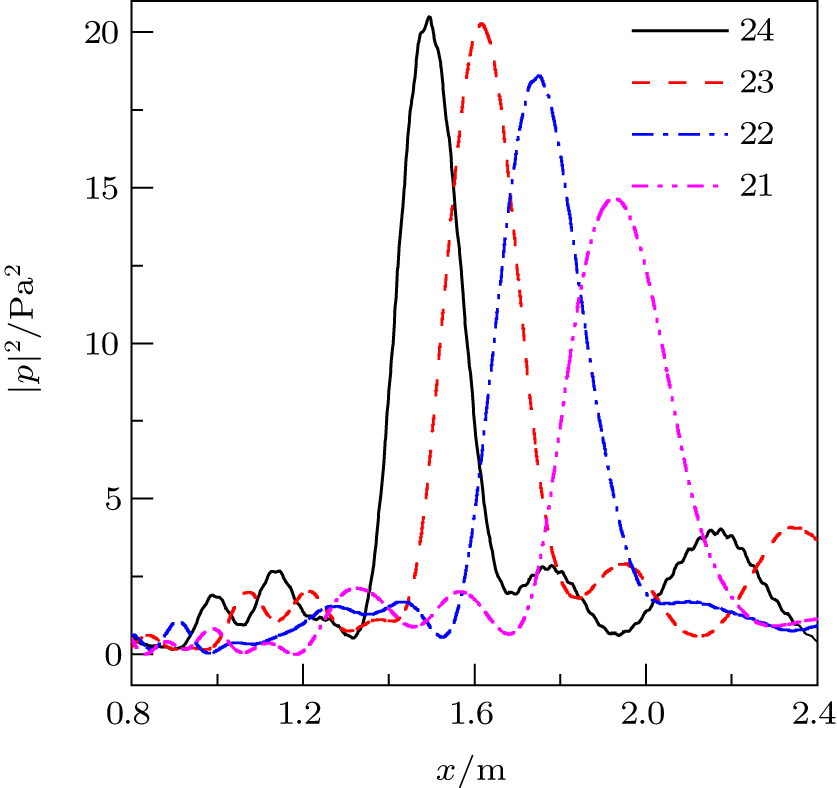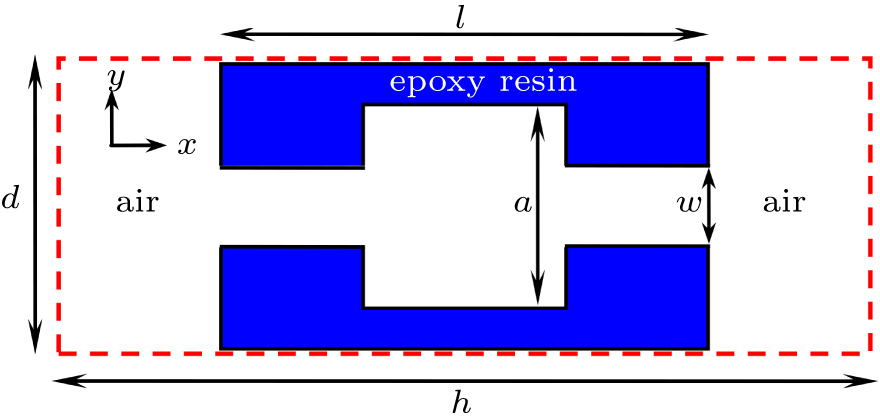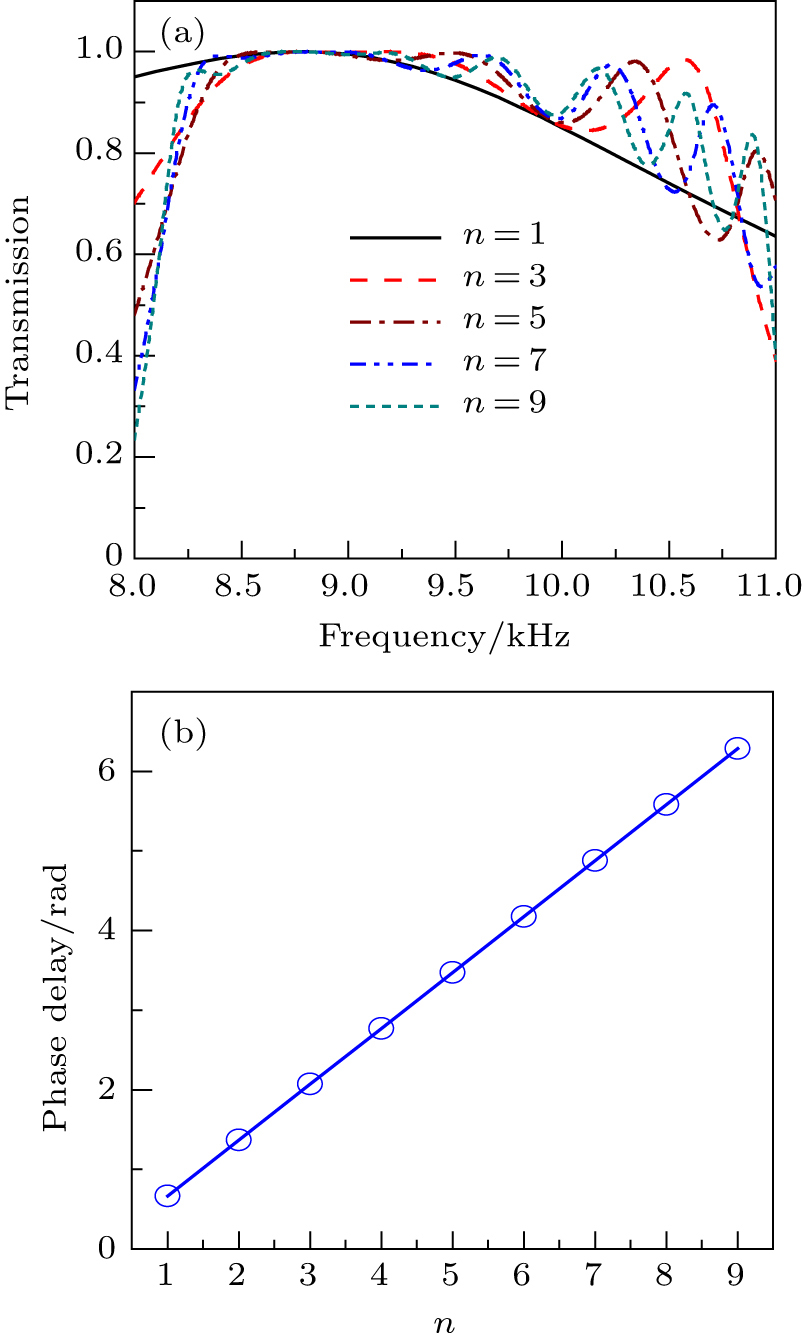† Corresponding author. E-mail:
Project supported by the National Natural Science Foundation of China (Grant Nos. 11774137 and 11404147), the Major Program of the National Natural Science Foundation of China (Grant No. 51239005), the Natural Science Foundation of Jiangsu Province, China (Grant Nos. BK20140519 and BK20140523), the Jiangsu Qing Lan Project, China, and the Practice Innovation Training Program Projects for Industrial Center of Jiangsu University, China.
We realize broadband acoustic focusing effect by employing two symmetric Airy beams generated from phased arrays, in which the units of the phased arrays consist of different numbers of cavity structures, each of which is composed of a square cavity and two inclined channels in air. The exotic phenomenon arises from the energy overlapping of the two symmetric Airy beams. Besides, we demonstrate the focusing performance with high self-healing property, and discuss the effects of structure parameters on focusing performance, and present the characteristics of the cavity structure with straight channels. Compared with other acoustic lenses, the proposed acoustic lens has advantages of broad bandwidth (about 1.4 kHz), high self-healing property of focusing performance, and free adjustment of focal length. Our finding should have great potential applications in ultrasound imaging and medical diagnosis.
Acoustic focusing has extensive applications in many scenarios ranging from biomedical imaging to therapeutic ultrasound to non-destructive evaluation.[1–6] Conventional acoustic focusing lenses are designed by bending natural materials into specific shapes to change acoustic propagation paths, which inevitably leads to inherent geometrical and wave aberrations. The rapid expansion of sonic crystals (SCs)[7,8] and acoustic metamaterials[9–12] offers extreme acoustic parameters unattainable with natural materials, which provide alternative solutions to acoustic lenses design. The SCs have been adopted to design acoustic lenses with sound gradient-refractive indexes.[13–15] However, the sizes of these types of the lenses are large at low frequency. With the emergence of acoustic metamaterials,[16–19] a small and thin acoustic focusing lens has become possible, owing to the small size and large negative refractive index of unit. Recently, acoustic metasurfaces enable the design of planar acoustic lens with phase manipulation,[20–31] which is different from other acoustic lenses. Besides, the thickness of the planar lens is much smaller than its working wavelength, which markedly increases the potential for the integration of the acoustic lenses. In addition to the aforementioned lenses, we have realized the acoustic focusing lenses by using the thermoacoustic mechanism[32–35] and the acoustic metafiber,[36] which have advantages of high focusing performance and broad working bandwidth.
Despite the improvement of the focusing performance and device structure by using the SCs, the acoustic metamaterials and metasurfaces, the existing focusing mechanisms are inevitably affected by various scatterers in acoustic focusing paths. As a typical example, the influences of ribs on the focusing effect in the high intensity focused ultrasound (HIFU) treatment seriously restrict the treatments of deep-seated tumors inside the ribcage. Aiming at this problem, Gao et al.[29] proposed a new type of acoustic focusing lens based on symmetric self-bending beams with phase manipulations, which could circumvent scatterers in focusing paths. However, the acoustic lens is composed of a phased array with zero-index medium, which results in the narrow working bandwidth of the lens. However, in practical therapeutic ultrasound, it is highly desirable to effectively focus acoustic waves in a broad bandwidth in the presence of scatterers, which requires exploring the inherently distinct mechanism of acoustic focusing.
In this work, we propose a broadband acoustic focusing lens which consists of two symmetric phased arrays of Airy beam in air. The unit of the phased arrays is realized by using different numbers of cavity structures each of which is composed of a square cavity and two inclined channels, which has advantages of the easy fabrication and the flexible operation. The focusing effect is attributed to the energy overlapping of the two symmetric Airy beams. Furthermore, we demonstrate the self-healing property of the acoustic lens and discuss the effects of structure parameters on focusing performance in detail.
As shown in Fig.
Figure
Considering the acoustic waves with normal incidence along the x direction and the presence of discrete phase delays along the y direction, the refraction angle of the transmitted wave θt (measured from the x direction) can be obtained by using the generalized Snell’s law[37]
In the phased array of the Airy beam, the parameters a, b, θ, f, and c are selected as 0.5, 22, 0.5°, 7.95 kHz, and 343 m/s, respectively. The theoretical continuous phase delays along the y direction are shown as the blue solid line in Fig.
On the basis of the phased array for the Airy beam, we design an acoustic focusing lens composed of two identical phased arrays symmetric with respect to y = 0. The distribution of the acoustic intensity field induced by the theoretical continuous phase delays and the proposed acoustic lens are shown in Figs.
 | Fig. 4. (color online) Spatial distributions of acoustic intensity field induced by (a) theoretical continuous phase delays and (b) proposed acoustic lens at 7.95 kHz. |
To quantify the performance of the acoustic lens, we calculate the longitudinal and transverse distributions of the acoustic intensity through the focus (shown as lines I and II in Fig.
The acoustic focusing of the proposed lens exists in a broad working bandwidth. Figures
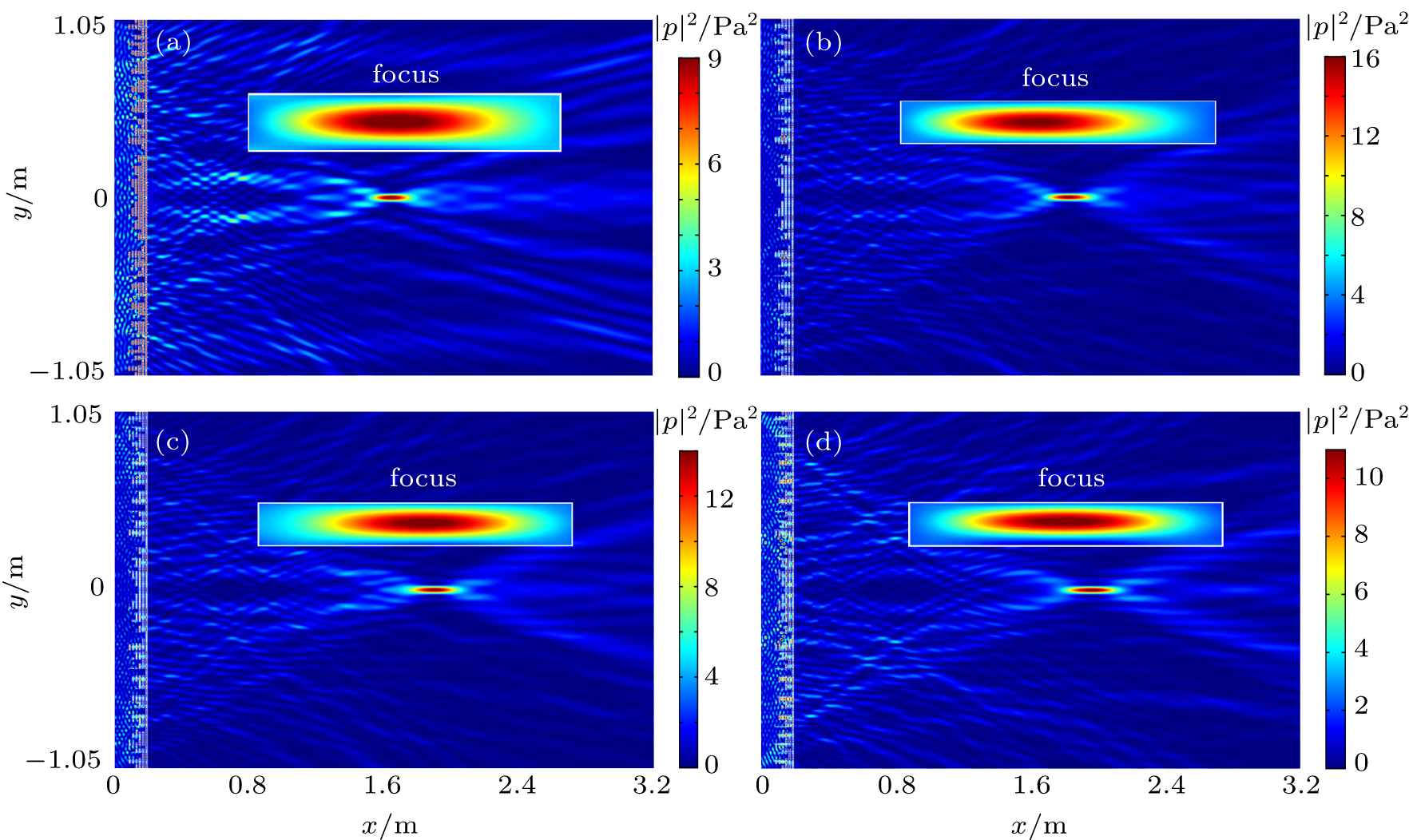 | Fig. 6. (color online) Spatial distributions of acoustic intensity field induced by acoustic lens at (a) 7.6 kHz, (b) 8.3 kHz, (c) 8.65 kHz, and (d) 9.0 kHz. |
In order to study the influence of a scatterer on the focusing performance, we place an elliptical scatterer on the acoustic focusing path. The distance between the center of the scatterer and the lens is 23 cm, and the semi-major and semi-minor axis of the ellipse scatterer are 15 cm and 9 cm, respectively. Figure
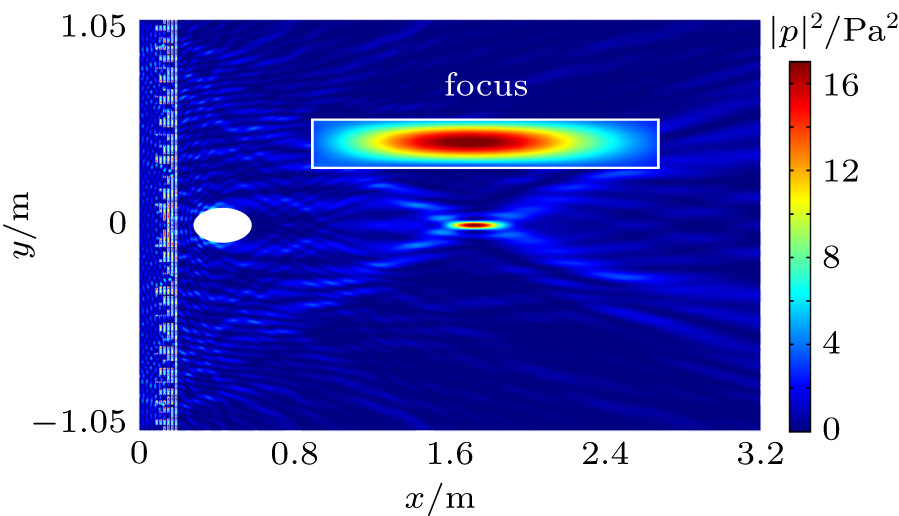 | Fig. 8. (color online) Spatial distribution of acoustic intensity field induced by acoustic lens with elliptical scatterer placed on acoustic focusing path. |
To further verify this, we design a traditional acoustic focusing lens with the same length along the y direction. Theoretical continuous and discrete phase delays for the half structure of the traditional acoustic lens are shown as the blue solid line and red hollow dots in Fig.
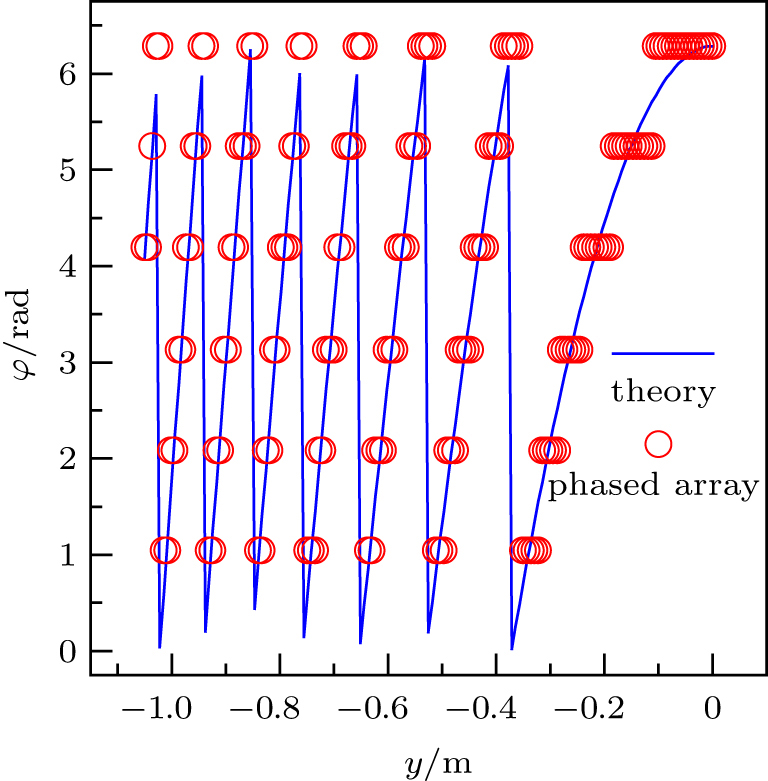 | Fig. 9. (color online) Theoretical continuous phase delays (blue line) and discrete phase delays (red hollow dots) for half structure of traditional acoustic focusing lens. |
Figure
We also discuss the influences of the structure parameters (θ and b) on the focusing performance. Figures
According to the phased arrays of the Airy beam in Figs.
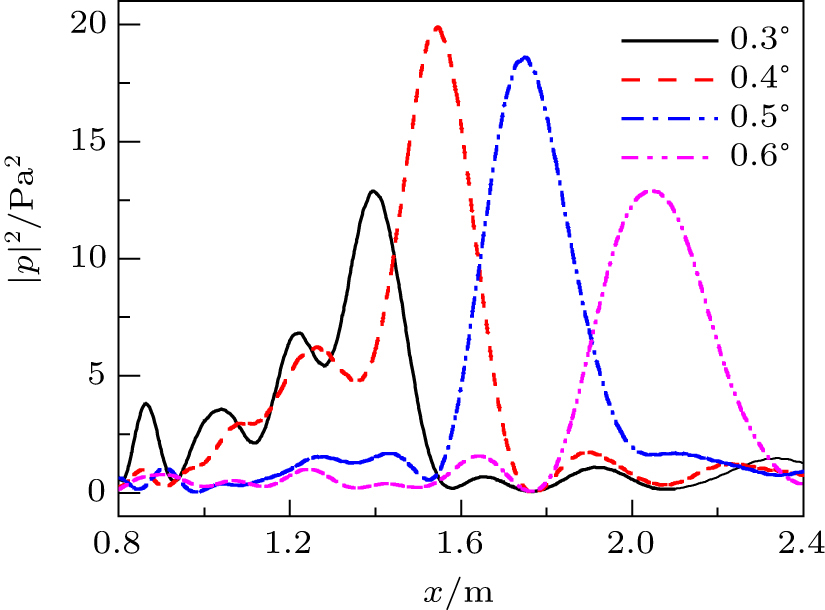 | Fig. 13. (color online) Transverse distributions of acoustic intensity through focus for acoustic lenses with different values of parameter θ. |
Figures
We find that with the increase of b, the focus shifts toward the left and the focal length gradually decreases, which arises from the decreasing of the distance between the main lobe and the phased array. In addition, we calculate the transverse distributions of the acoustic intensity through the focus with different values of b, which is shown in Fig.
To show the motivation of using the cavity structure with inclined channels, we calculate the characteristics of the cavity structure with two symmetric straight channels (Fig.
In this study, we realize a broadband acoustic focusing effect through two symmetric phased arrays of Airy beam in air. The results show that the units of the phased arrays consist of different numbers of the cavity structures with inclined channels, which have advantages of easy fabrication and flexible operation. The phase delays of the units could span entire 2π range by using six cavity structures with inclined channels, which is less than those with straight channels. The focusing effect stems from the energy overlapping of the two symmetric Airy beams. Owing to the self-bending and self-healing features, the ability to circumvent a scatterer of the proposed acoustic lens is greater than that of traditional acoustic lenses. Moreover, the bandwidth of the focusing effect increases up to 1.4 kHz, and the focal length of the lens can be controlled by adjusting incident frequency and parameters θ and b. The above results provide the theoretical basis for designing broadband acoustic focusing lenses, which have great potential applications in ultrasound imaging and medical diagnoses.
| [1] | |
| [2] | |
| [3] | |
| [4] | |
| [5] | |
| [6] | |
| [7] | |
| [8] | |
| [9] | |
| [10] | |
| [11] | |
| [12] | |
| [13] | |
| [14] | |
| [15] | |
| [16] | |
| [17] | |
| [18] | |
| [19] | |
| [20] | |
| [21] | |
| [22] | |
| [23] | |
| [24] | |
| [25] | |
| [26] | |
| [27] | |
| [28] | |
| [29] | |
| [30] | |
| [31] | |
| [32] | |
| [33] | |
| [34] | |
| [35] | |
| [36] | |
| [37] |




